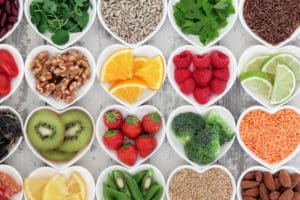What are the Dirty Dozen and Clean Fifteen Fruits and Vegetables?

“Nearly 75 percent of non-organic fresh produce sold in the U.S. contains residues of potentially harmful pesticides,” according to the Environmental Working Group, a nonprofit organization that aims to create a healthier environment.
Any exposure to pesticides is a problem, given what we know about several ways they can harm humans. But the findings are particularly concerning for children, who are particularly vulnerable to many of the health harms associated with pesticide exposure.
A recent EWG investigation published in the peer-reviewed journal Environmental Health found that the EPA has failed to adequately protect children from pesticides. For almost 90 percent of the most common pesticides, the agency has neglected to apply the Food Quality Protection Act–mandated children’s health safety factor to the allowable limits.
WHAT’S NEW IN THE 2023 SHOPPER’S GUIDE
Blueberries and green beans are on the Dirty Dozen this year. Both crops still have troubling concentrations of pesticides that can harm the human nervous system, called organophosphate insecticides, though the levels have decreased over the past decade.
Several green bean samples had residues of acephate, a toxic pesticide, which the EPA banned more than 10 years ago from use on green beans grown for food.
Also this year, cantaloupe was removed from the Clean Fifteen, and carrots were added.
Here’s the 2023 ‘Dirty Dozen’
Here’s the full list of the top 12 fruits and vegetables with the most pesticides this year.
- Strawberries
- Spinach
- Kale, collard & mustard greens
- Peaches
- Pears
- Nectarines
- Apples
- Grapes
- Bell & hot peppers
- Cherries
- Blueberries
- Green beans
Her are some highlights from the Dirty Dozen testing:
- More than 90 percent of samples of strawberries, apples, cherries, spinach, nectarines and grapes tested positive for residues of two or more pesticides.
- A total of 210 pesticides were found on Dirty Dozen items.
- Of those, over 50 different pesticides were detected on every type of crop on the list, except cherries.
- All of the produce on the Dirty Dozen had at least one sample with at least 13 different pesticides — and some had as many as as many as 23.
- Kale, collard and mustard greens, as well as hot peppers and bell peppers, had the most pesticides detected of any crop — 103 and 101 pesticides in total, respectively.
- The neurotoxic organophosphate insecticide acephate, prohibited from use on green beans in 2011, was detected on six percent of green bean samples.
The ‘Clean 15’ is the top 15 conventional fruits & veggies with the least amount of pesticide residue.
- Avocados
- Sweet Corn*
- Pineapple
- Onions
- Papaya*
- Sweet Peas (Frozen)
- Asparagus
- Honeydew Melon
- Kiwi
- Cabbage
- Mushrooms
- Mangoes
- Sweet Potatoes
- Watermelon
- Carrots
Top takeaways for consumers:
- Almost 65 percent of Clean Fifteen fruit and vegetable samples had no detectable pesticide residues.
- Avocados and sweet corn were the cleanest produce – less than 2 percent of samples showed any detectable pesticides.
- Just over 10 percent of Clean Fifteen fruit and vegetable samples had residues of two or more pesticides.
- No sample from the first six Clean Fifteen items tested positive for more than three pesticides.
